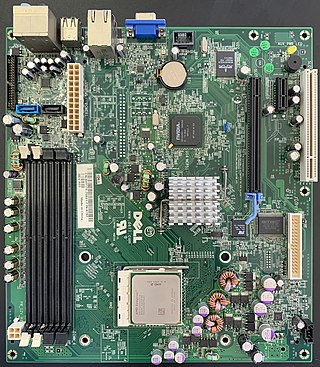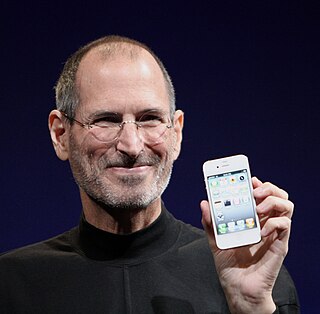Related Research Articles

Computer engineering is a branch of computer science and electronic engineering that integrates several fields of computer science and electronic engineering required to develop computer hardware and software. Computer engineering is referred to as computer science and engineering at some universities.

The iPod is a discontinued series of portable media players and multi-purpose mobile devices designed and marketed by Apple Inc. The first version was released on October 23, 2001, about 8+1⁄2 months after the Macintosh version of iTunes was released. Apple sold an estimated 450 million iPod products as of 2022. Apple discontinued the iPod product line on May 10, 2022. At over 20 years, the iPod brand is the oldest to be discontinued by Apple.

The Macintosh II is a personal computer designed, manufactured, and sold by Apple Computer from March 1987 to January 1990. Based on the Motorola 68020 32-bit CPU, it is the first Macintosh supporting color graphics. When introduced, a basic system with monitor and 20 MB hard drive cost US$5,498. With a 13-inch color monitor and 8-bit display card the price was around US$7,145. This placed it in competition with workstations from Silicon Graphics, Sun Microsystems, and Hewlett-Packard.

Anthony Michael Fadell is an American engineer, designer, entrepreneur, and investor. He was senior vice president of the iPod division at Apple Inc. and founder and former CEO of Nest Labs.
Leonard X. Bosack is a co-founder of Cisco Systems, an American-based multinational corporation that designs and sells consumer electronics, networking and communications technology, and services. His net worth is approximately $200 million. He was awarded the Computer Entrepreneur Award in 2009 for co-founding Cisco Systems and pioneering and advancing the commercialization of routing technology and the profound changes this technology enabled in the computer industry.

The Milwaukee School of Engineering (MSOE) is a private university in Milwaukee, Wisconsin. The 22-acre (8.9 ha) campus is in the East Town neighborhood of downtown Milwaukee. In the fall of 2022, it enrolled 2,575 undergraduate and 154 graduate students. As of fall 2018, the university had a total of 138 full-faculty, more than 33% of which are women. Through eight academic departments, the university offers 16 bachelor's degree programs, 10 of which are in engineering. The university also offers nine master's degrees.

Apple Inc., originally named Apple Computer, Inc., is a multinational corporation that creates and markets consumer electronics and attendant computer software, and is a digital distributor of media content. Apple's core product lines are the iPhone smartphone, iPad tablet computer, and the Macintosh personal computer. The company offers its products online and has a chain of retail stores known as Apple Stores. Founders Steve Jobs, Steve Wozniak, and Ronald Wayne created Apple Computer Co. on April 1, 1976, to market Wozniak's Apple I desktop computer, and Jobs and Wozniak incorporated the company on January 3, 1977, in Cupertino, California.

Jonathan J. "Jon" Rubinstein is an American electrical engineer who played an instrumental role in the development of the iMac and iPod, the portable music and video device first sold by Apple Computer Inc. in 2001. He left his position as senior vice president of Apple's iPod division on April 14, 2006.
Edward P. ("Skip") Stritter, engineer and entrepreneur, was the chief architect of the Motorola 68000 microprocessor, a co-founder of the first commercial RISC company MIPS Computer Systems, the founder of Clarity Wireless, and founder of NeTPower. He also served on the Board of Overseers of the Thayer School of Engineering at Dartmouth College. He was nominated by the United States Justice Department to serve on a three-member technical board of overseers to ensure that Microsoft complied with the judgements of United States v. Microsoft.
The College of Engineering and Applied Science is a college within the University of Wisconsin–Milwaukee. It offers bachelor, master and doctoral degrees in civil engineering, electrical engineering, industrial engineering, materials engineering, mechanical engineering, and computer science.

The history of the iPhone development by Apple Inc. spans from the early 2000s to about 2010. The first iPhone was released in 2007. By the end of 2009, iPhone models had been released in all major markets.
The following outline is provided as an overview of and topical guide to computer engineering:
John P. Morgridge is an American businessman who was the CEO and chairman of the board of Cisco Systems.

Mark D. Papermaster is an American business executive currently serving as the chief technology officer (CTO) and executive vice president for technology and engineering at Advanced Micro Devices (AMD). On January 25, 2019 he was promoted to AMD's Executive Vice President. Papermaster previously worked at IBM from 1982 to 2008, where he was closely involved in the development of PowerPC technology and served two years as vice president of IBM's blade server division. Papermaster's decision to move from IBM to Apple Inc. in 2008 became central to a court case considering the validity and scope of an employee non-compete clause in the technology industry. He became senior vice president of devices hardware engineering at Apple in 2009, with oversight for devices such as the iPhone. In 2010 he left Apple and joined Cisco Systems as a VP of the company's silicon engineering development. Papermaster joined AMD on October 24, 2011, assuming oversight for all of AMD's technology teams and the creation of all of AMD's products, and AMD's corporate technical direction.

The University of Wisconsin–Madison is a public land-grant research university in Madison, Wisconsin. Founded when Wisconsin achieved statehood in 1848, UW–Madison is the official state university of Wisconsin and the flagship campus of the University of Wisconsin System. It was the first public university established in Wisconsin and remains the oldest and largest public university in the state. UW–Madison became a land-grant institution in 1866. The 933-acre (378 ha) main campus, located on the shores of Lake Mendota, includes four National Historic Landmarks. The university also owns and operates the 1,200-acre (486 ha) University of Wisconsin–Madison Arboretum, located 4 miles (6.4 km) south of the main campus, which is also a National Historic Landmark.
The Morgridge Institute for Research is a private, nonprofit biomedical research institute in Madison, Wis., affiliated with the University of Wisconsin–Madison. The institute works to improve human health by conducting, enabling and translating interdisciplinary biomedical research. Research in regenerative biology, virology, medical devices and core computational technology is currently underway.
The following outline of Apple Inc. is a topical guide to the products, history, retail stores, corporate acquisitions, and personnel under the purview of the American multinational corporation Apple Inc.
Victor Tsao, or Ts'ao Ying-wei, is a Taiwanese-born American entrepreneur and hardware engineer. Tsao and his wife Janie co-founded Linksys, a consumer home networking pioneer, and sold the company to Cisco Systems for $500 million in 2003.
Michael J. Barber is an American engineer who is an executive at General Electric. His research considers X-ray electronics. He was elected Fellow of the American Institute for Medical and Biological Engineering in 2014.
References
- ↑ Design News Engineer of the Year [ permanent dead link ]
- ↑ 2007 Engineer of the Year Finalist Michael Dhuey's Hardware Knowledge Helps Breathe Life Into iPod, TelePresence
- ↑ "Focus on alumni: Michael Dhuey", Wisconsin*Engineering*Alumni*Perspective, Winter 2008 (Vol. 34, No. 2).